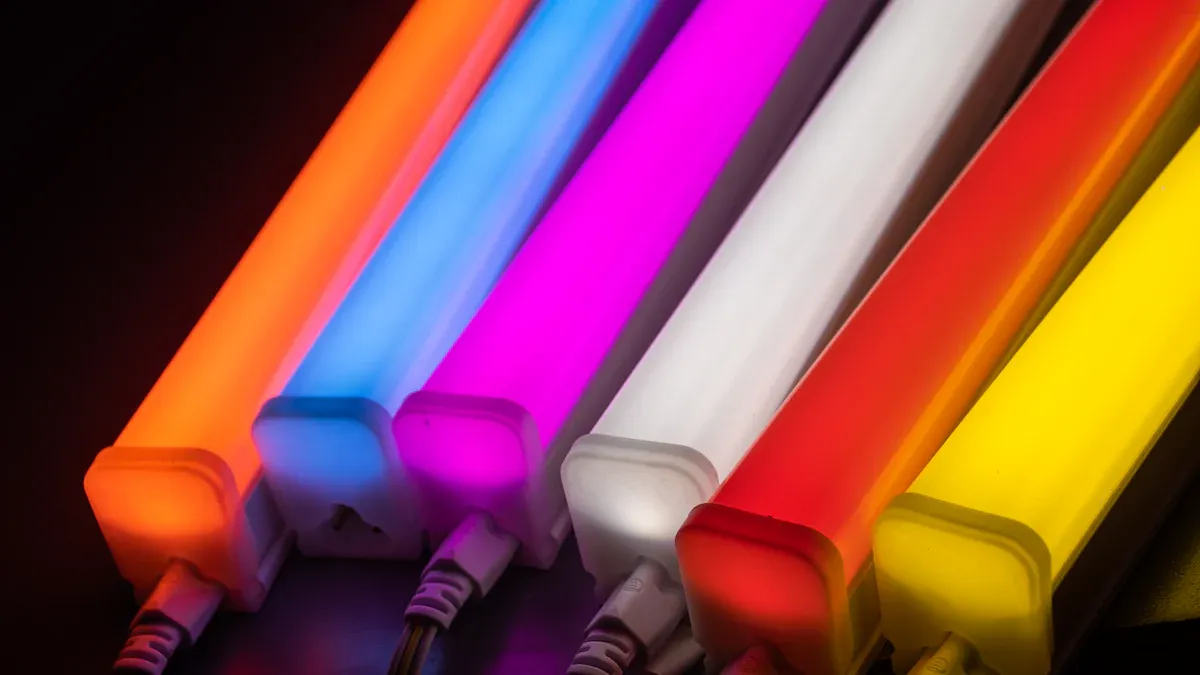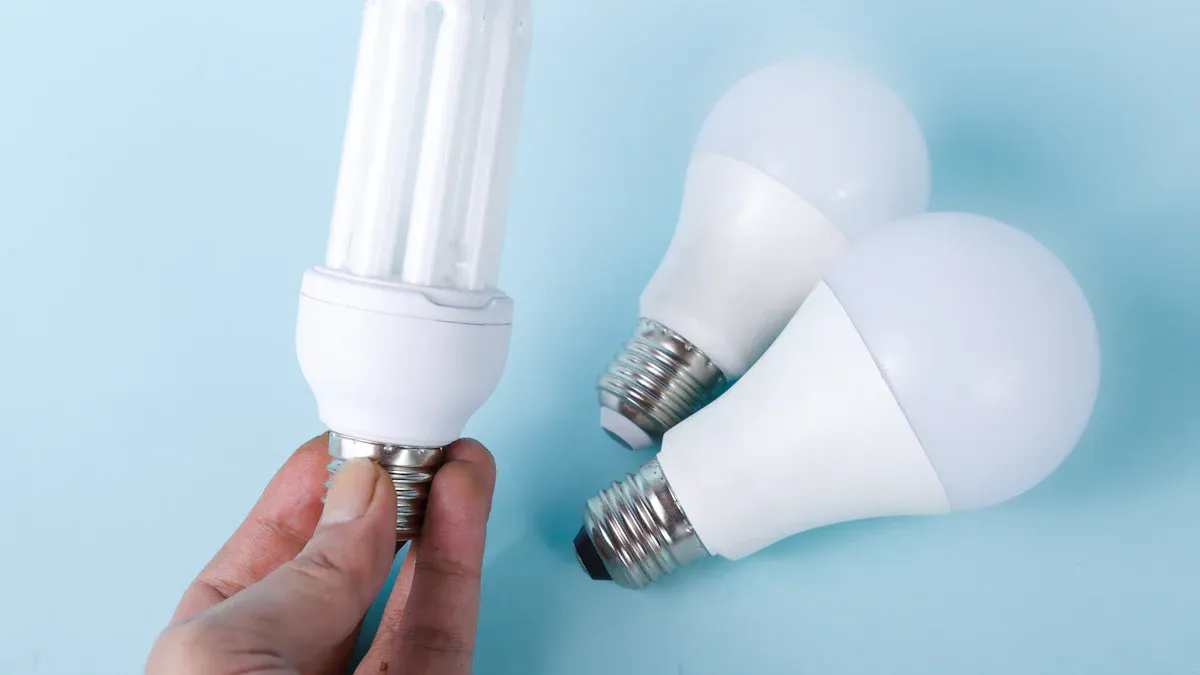How to Measure LED Tubes and Select the Right LED Replacement Tubes for Your Fluorescent Fixtures

Switching to LED tubes might seem tricky, but knowing how to measure LED tubes correctly is key. If you don’t measure them right, they might not fit your fixtures. Taking this simple step avoids problems and makes things easier.
Why switch to LED light? LED tubes are amazing. They use less energy, turning about 90% of it into light, while fluorescent lights only use 85%. They also last longer—up to 50,000 hours compared to 10,000 to 20,000 hours for fluorescent tubes. This means fewer replacements and lower energy costs. LEDs are also better for the planet. They make less heat, need less upkeep, and don’t need time to warm up like fluorescents. With LED tubes, you save money and help the environment. It’s a win for everyone!
Key Takeaways
Measure LED tubes carefully to make sure they fit. Use a tape measure for length and a ruler for width.
Pick the right brightness and power for your room. Low-power LEDs can still give bright light and save energy.
Learn about the types of LED tubes: ballast-compatible, ballast-bypass, and hybrid. Each type installs differently and has its own benefits.
Be safe when installing. Turn off the power and wear safety gear to prevent accidents.
Check how much energy you save by comparing fluorescent lights to LED tubes. This shows how switching can save you money.
How to Measure LED Tubes

Getting the right size is very important. If you measure wrong, the tubes won’t fit. Let’s go through it step by step.
Measuring Length
Use a tape measure to check the tube’s length. Start at one end and measure to the other, including the pins. This gives the full size. Most LED tubes are 2 feet, 4 feet, or 8 feet long. The length often matches the wattage, so check it with your old tube. This simple check avoids problems later.
Determining Diameter
The tube’s width matters as much as its length. LED tubes are grouped by diameter using "T" ratings. For example, T8 tubes are 1 inch wide, and T12 tubes are 1.5 inches wide. Use a ruler or caliper to measure the width. Knowing this helps you pick the right tube for your fixture.
Identifying Pin Types
The pins on the tube ends are also important. LED tubes have different pin setups, like single-ended or double-ended. Here’s a simple guide:
LED Tube Type | Tombstone Compatibility | Notes |
|---|---|---|
Single-ended | Non-shunted tombstones only | Needs opposite polarity to work. |
Double-ended | Shunted and non-shunted | Works with both types. |
Direct Wire (Type-B) | Non-shunted required | Skips ballast, may need rewiring. |
Electronic Ballast Compatible | Shunted or non-shunted | Works with ballasts, no rewiring needed. |
To check your tombstone type, use a voltmeter. If using single-ended tubes, you might need to rewire or replace shunted tombstones. Always follow the wiring guide for safety.
By doing these steps, your LED tubes will fit and work well.
Choosing the Right LED Replacement Tubes
Fixture Compatibility
Before buying an LED tube, check if it fits your fixture. Not all tubes work with every fixture. Using the wrong one can cause problems or damage. Here’s a simple guide to check:
Compatibility Type | What It Means | How to Test |
|---|---|---|
Mechanical | Tube fits in the fixture. | Use thermocouples to test fit. |
Thermal | Handles heat safely. | Check base temperature and heatsink. |
Electrical | Matches fixture’s power needs. | Test with dimmers and transformers. |
By checking these, you’ll avoid problems and get the right tube.
Wattage and Brightness
Choose the right wattage and brightness for your needs. Higher wattage doesn’t always mean better light. It can waste energy if it’s too much. LEDs are efficient, so even low-wattage ones can be bright.
Here’s how to pick:
Figure out how bright the room should be.
Divide the needed lumens by lumens per watt of the LED.
LEDs give 100-120 lumens per watt, more than fluorescents.
For example, in a small office, a low-wattage LED might work best. It saves energy and still lights the space well.
Tube Types (T5, T8, T12)
LED tubes come in different types. Knowing the differences helps you choose. The common ones are T5, T8, and T12. Each type has special features:
Type | Width | Usual Wattage | Length (mm) |
|---|---|---|---|
T5 | 5/8 inch (15mm) | 8 watts | 310 |
T8 | 1 inch (25mm) | 20 watts | 620 |
T12 | 12/8 inch (40mm) | 60 watts | 1219.2 |
T5 tubes are small and good for homes.
T8 tubes are common in places like hospitals.
T12 tubes are bigger and less efficient but used in old fixtures.
LED tubes last over 50,000 hours, much longer than fluorescents. They also give more light per watt, making them a great upgrade.
Types of LED Tubes

When upgrading fluorescent lights, know the types of LED tubes. Each type has special features and different ways to install. Let’s explain them so you can pick the best one.
Ballast-Compatible Tubes
Ballast-compatible LED tubes are also called Type A or direct-fit. These are the easiest to install. They work with your current ballast, so no rewiring is needed. Just take out the old fluorescent tube and plug in the LED tube. It’s super easy!
These tubes are great for quick upgrades with little effort. But they need a working ballast to function. If the ballast is old or doesn’t match, the tube might flicker or not work well.
Description | Installation Method | |
|---|---|---|
Type A (Direct Fit) | Replaces fluorescent tubes without rewiring. | Plug-and-Play, needs working ballast. |
Ballast-Bypass Tubes
Ballast-bypass LED tubes are also called Type B tubes. These don’t use a ballast. Instead, they connect straight to the fixture’s power. This removes problems caused by bad ballasts.
To install, you must rewire the fixture. It takes more time but makes the system simpler and lowers maintenance costs. Be careful, though—bypassing the ballast can be unsafe if done wrong. Always follow instructions or hire an expert.
Why choose ballast-bypass tubes?
They avoid issues with old ballasts.
They make the lighting system easier and more reliable.
But there are downsides. Rewiring can be hard, and mistakes can cause electric shocks.
Hybrid LED Tubes
Hybrid LED tubes, or Type A/B tubes, are very flexible. They work with or without a ballast. First, you can use them as direct-fit tubes. Later, if the ballast breaks, you can rewire to bypass it.
This makes hybrid tubes a smart choice for older fixtures. They’re great if you want to upgrade slowly without changing everything at once.
Type of LED Tube | Description | Installation Method |
|---|---|---|
Type A/B (Hybrid) | Works as direct-fit or with ballast bypass. | Flexible and good for older fixtures. |
When picking a type, think about your setup and future plans. Whether you need a fast fix or a lasting solution, there’s an LED tube for you.
Tips for Upgrading to LED Tubes
Switching to LED tubes may seem hard, but it’s simple with the right steps. Follow these tips to make your upgrade safe, easy, and worth the cost.
Installation and Safety
Putting in LED tubes needs careful attention to safety. Use these steps to do it right:
Turn off the power at the breaker before starting.
Take out the old fluorescent tube carefully. Wear gloves and goggles to stay safe.
Place the LED tube into the fixture. For plug-and-play types, check if the ballast works with it.
Turn the power back on and test the lights.
Pro Tip: Always read the manufacturer’s guide for specific instructions. Use insulated tools and work at ground level for extra safety.
Single-end powered (SEP) tubes are safer to install than double-end powered (DEP) ones. Also, make sure your LED tubes meet safety rules like UL standards, especially for line voltage setups.
Calculating Energy Savings
Switching to LED lighting saves money and energy. Here’s how to figure out your savings:
Look at your utility bill to find the cost per kilowatt hour (kWh).
Calculate how much energy your fluorescent lights use:
(Number of Tubes × Fixture Wattage × Annual Run Hours) ÷ 1,000.Do the same for your new LED system.
Compare the two numbers to see your energy savings.
For example, if your fluorescent lights use 1,000 kWh a year and your LED upgrade lowers this to 250 kWh, you save 750 kWh. That’s great for your wallet and the planet!
Maximizing ROI
Upgrading to LEDs is an investment, so getting the most out of it matters. LEDs use up to 75% less energy than regular bulbs, cutting electricity costs. They also last up to 50,000 hours, reducing maintenance expenses.
Here’s how others have saved:
King GMC Auto cut $40,000 from yearly costs after switching to LED lighting.
Crossroads Church saved $70,578 in total operating costs.
Washtime Car Wash saved $48,260 over 10 years with an LED retrofit.
To increase your ROI, try a hybrid LED retrofit kit. It lets you upgrade slowly, spreading out costs while enjoying LED benefits.
Quick Tip: Check your LED tubes often to ensure they work well. This keeps them efficient and gives you the best value for your money.
Switching to LED tubes is a great choice for homes or businesses. They have amazing advantages:
Use 75% less energy than regular light bulbs.
Last 25 times longer, so fewer replacements are needed.
Save 80-90% on energy bills compared to old bulbs.
A study of 300 Malaysian groups found that using LED lights helps the environment and saves money. Pressure from others often encourages this change.
By switching to LED tubes, you’ll save money, need less upkeep, and protect the planet. Start by measuring your fixtures and picking the right tubes. It’s an easy way to make your space brighter and more efficient.
FAQ
What’s the difference between T5, T8, and T12 LED tubes?
T5 tubes are slim and fit small spaces. T8 tubes are common in offices and hospitals. T12 tubes are wide, less efficient, and used in older fixtures. Pick based on your fixture size and energy needs.
Can I use LED tubes in my current fluorescent fixtures?
Yes, but it depends on the LED tube type. Ballast-compatible tubes fit without changes. Ballast-bypass tubes need rewiring. Hybrid tubes work both ways, with or without a ballast. Always check if your fixture matches the tube.
How can I tell if my ballast works with LED tubes?
Look at the LED tube’s box or manual for details. You can also search your ballast model online. If unsure, hybrid or ballast-bypass tubes are safer choices. They work even if the ballast isn’t compatible.
Are LED tubes safe to install on my own?
Yes, but follow safety steps. Turn off power at the breaker. Wear gloves and use insulated tools. For ballast-bypass tubes, follow wiring instructions carefully. If unsure, hire an expert to stay safe and install correctly.
How much energy will I save by switching to LED tubes?
LED tubes use 75% less energy than fluorescent lights. For example, replacing a 40-watt fluorescent with a 15-watt LED saves 25 watts per tube. Multiply this by the number of tubes and hours used to find your savings.
See Also
Your Complete Guide to Swapping Fluorescent Tubes for LEDs
Transforming to LED: An In-Depth Guide for Tube Replacement
Choosing Ideal LED Bulbs for Various Light Fixture Types
Tips for Selecting the Best LED Lights for Your Space
Exploring LED Replacement Lights: Varieties, Advantages, and Setup

